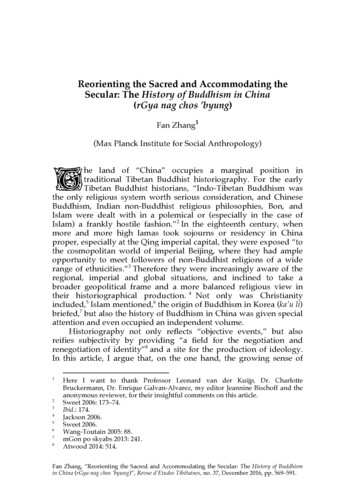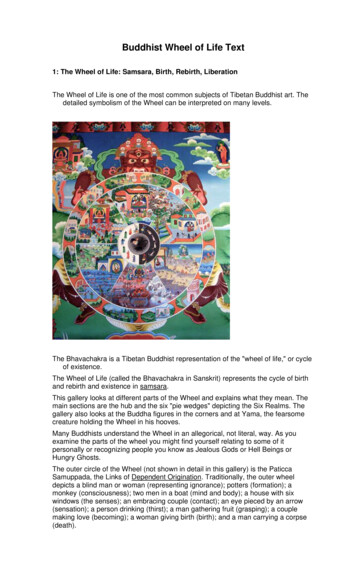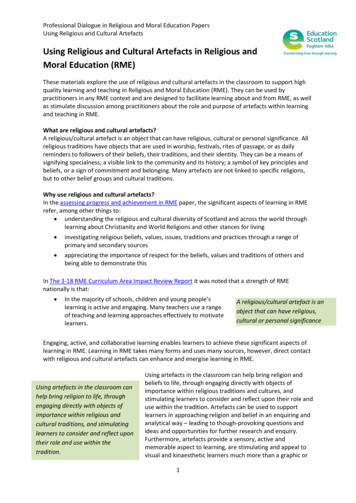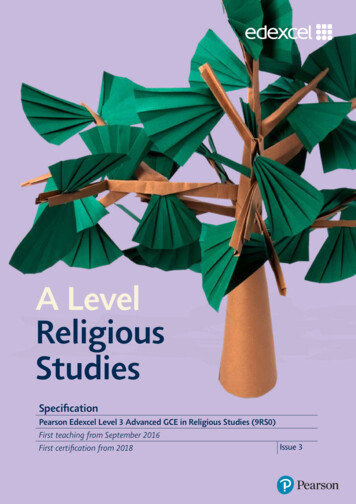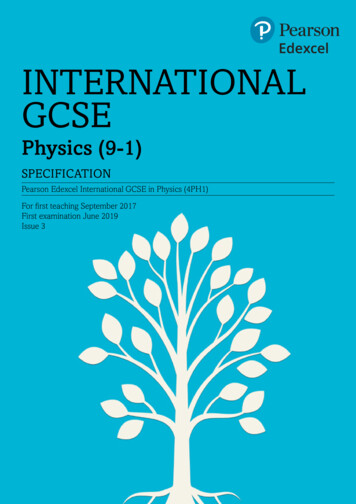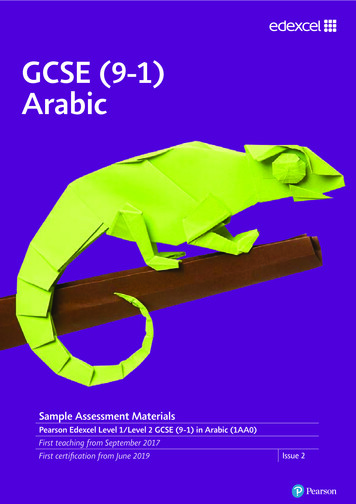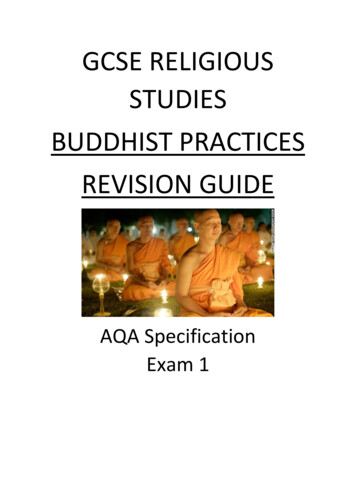
Transcription
GCSE RELIGIOUSSTUDIESBUDDHIST PRACTICESREVISION GUIDEAQA SpecificationExam 1
The specification - This is what the exam board say you have to knowStudents should be aware that Buddhism is one of the diverse religious traditions and beliefs inGreat Britain today and that the main religious tradition in Great Britain is Christianity. Thisknowledge may be applied throughout the assessment of the specified content.Students should study the beliefs, teachings and practices of Buddhism specified below and theirbasis in Buddhist sources of wisdom and authority. They should be able to refer to scripture and/ orsacred texts where appropriate. Some texts are prescribed for study in the content set out belowand questions may be set on them.Students should study the influence of the beliefs, teachings and practices studied on individuals,communities and societies.Common and divergent views within Buddhism in the way beliefs and teachings are understood andexpressed should be included throughout. Students may refer to a range of Buddhist perspectives intheir answers, for example, Theravada, Mahayana, Zen and Pure Land.Buddhist Beliefs andTeachingsPlaces of WorshipHow Buddhists WorshipMeditationSamatha MeditationVipassana MeditationThe visualisation of Buddhasand BodhisattvasCeremonies and ritualsassociated with death andmourningWesak and Paranirvana DayKamma (karma) and RebirthCompassion (karuna)Loving-kindness (metta)The five moral preceptsThe six perfectionsWhen you revisedY10 Summer Y11holidays up toexam
Exam InformationYou are completing the Full Course GCSE Religious Studies Specification A withthe exam board AQA. At the end of year 11 you will have to sit 2 exams.Exam 1 Paper 1APaper Reference 8062/1AYou have to have studied two religions andanswer on both. You have studied Christianityand Buddhism.DO NOT ATTEMPT TO DO ANOTHER RELIGIONYOU WILL NOT KNOW ENOUGH.Christianity and Catholic Christianity are notthe same make sure you do not answer theincorrect one.On each religion, there are 10 parts (individualquestions to answer) 5 of these will be onbeliefs/teachings and the other 5 will be onpractices. We know the types of questionsthat will be asked for and how many markseach of these will be out of. You will havepracticed this throughout the GCSE butguidance is also offered here.The maximum mark for this paper is 101. Themarks for questions are shown in brackets.Spelling, Punctuation and Grammar (SPaG) willbe assessed in the 12 mark questions. Themarks for SPaG are shown below the markallocation for each question. The best of thesemarks will be included in your total for thepaper.The paper is 1 hour 45 minutes long. You areadvised by the exam board to spend 50minutes on each religion.Exam 2 Paper 2APaper Reference 8062/2AYou have studied four themes. In this examyou are tested on your knowledge of thesefour themes and religious views. You have toknow both the Christian and the Buddhistviews as well as your own.The four themes you have studied are:Theme A Relationships and familiesTheme B Religion and LifeTheme D Religion, peace and conflictTheme E Religion, crime and punishmentTDO NOT ANSWER ANY OF THE OTHER THEMESIN THE BOOKLET. YOU ONLY HAVE TO DOFOUR AND YOU HAVE NOT LEARNT THEOTHERS.Each theme will have 5 parts. We know thetypes of questions that will be asked for andhow many marks each of these will be out of.You will have practiced this throughout theGCSE but guidance is also offered here.The maximum mark for this paper is 96 plus 5marks for Spelling, Punctuation and Grammar.The marks for questions are shown in brackets.Spelling, Punctuation and Grammar (SPaG) willbe assessed in the 12 mark questions. Themarks for SPaG are shown below the markallocation for each question. The best of thesemarks will be included in your total for thepaper.The paper is 1 hour 45 minutes long. You areadvised to spend 25 minutes on each theme.
Places of WorshipBuddhists can worship at home or in a communal space such as a temple.TempleA temple is at the heart of a Buddhist community. Temples come in many different shapes and sizes;some even have many buildings. Temples may include the following: A main hall where Buddhists practice together. This will include a statue or statues of theBuddhaA meditation hall, only for meditation (this is called a gompa in Tibetan Buddhism)A study hall for meetings or lecturesA shrine (Bodhisattva in Mahayana Buddhism) dedicated to the BuddhaA pogoda or stupa, which is a tiered tower or mound like structure used to contain holyrelicsTemples are important places because Buddhists come together to study, meditate and practicetogether. Lay Buddhists may listen to talks given by Monks. Lay people often take offerings tosupport members of the monastic community.The focus of the Shrine isShrinesthe statue of the Buddha(the Buddha rupa)Buddhists make offerings at a shrine,as a way of paying respect to theBuddha. They symbolise differentShrines can be found in aaspects of his teachings:temple or a home; they area focus of meditation An offering of light (candle)symbolises wisdom. The light“The time and effortdrives away the ignorance ofrequired to keep the shrinedarknessclean and replenished with An offering of flowers (whichflowers ad other offerings iswill die) signifies thatconsidered a skilful activityeverything is impermanentto focus one’s mind in the An offering of incensespiritual practices”symbolises purity, remindingBuddhists of the importanceof practicing pure thoughts,speech and conduct.Lama Choedak Rinpoche(Tibetan Buddhist Monk)Monastaries (Viharas) A building where a community of monks or nuns live to spend their lives dedicated to theirspiritual practice, where they live a simple lifestyle.A stupa is really important because it contains relics to symbolise where Buddha wascremated and his ashes were left to rest after his death.Revision activity: Explain why temples and their contents are important for Buddhists.
How do Buddhists worship?What’s the purpose? Express gratitude and respect for Buddha and show how important he is in their livesFocus on their faith by developing their understanding of Buddha’s teachingsRemind themselves of the nature of existence (way of life), leading to the wisdom andcompassion of enlightenment.How do Buddhists worship?Chanting Before written texts, Buddhistsmemorised the teachings and passedthem on by word of mouth Today, Buddhists still chant sacred textssuch as; the three refuges, five moralprecepts and Bodhisattva vows. Chanting is a devotional practice: theaim is to make sure that peopleunderstand the teachings of Buddha ingreater depth, as well as to concentrateand clear the mindReciting Mantras A mantra is a sequence of sacredsyllables that is usually chanted overand over, some times spoken andsometimes experienced in the mind Some Buddhists believe that mantrashave transformative powers They can be used in meditation to focusthe mind and call on the spiritualqualities of the Buddha The most common mantra in TibetanBuddhism is ‘om mani padme hum’which means The word Mani means"jewel" or "bead", Padme is the "lotusflower" (the Buddhist sacred flower),and Hum represents the spirit ofenlightenment. This mantra helps them to understandcompassion and better help themexperience this quality in their lives Buddhists can recite a mantra hundredsor event thousands of time, often usinga mala (string of prayer beads, usuallywith 108 beads) in order to count thenumber of recitations.Revision activitiesMatch up the correct elements of Buddhist worship with the definitionsOfferingsMalaBowingChantingSacred textReciting mantrasMeditationReciting a passage from a Buddhist textA spiritual practice of reflecting deeply on Buddha’s teachingsand the nature of realityRepeating ‘om mani padme hum’ over and over againA chain of beads, used to count recitationsBending the body three times in front of shrine, to recall thethree refugesA text containing the Buddha’s teachingsFlowers and incense on a shrine
Meditation“ you should so train yourself that with respect to the seen there will be merely the seen, that with respectto the heard there will be merely the heard, that with respect to the sense there will be merely the sensed,that with respect to the cognised there will be merely the cognised.”The Buddha in the Udana p.8The Practice of Meditation Before starting, Buddhists might recite verses praising the three refuges: the Buddha, theDhamma and the SanghaTheravada Buddhists recite the five moral preceptsDuring meditation, the meditator focuses their attention on physical sensations, developingcalm and stability – whenever they notice that their mind has become distracted, theyrefocus on physical attributesBuddhists may focus on a variety of different objects, processes, character traits or emotionswhen they meditate; from a candle flame to the development of wisdomType of meditationSamatha MeditationVipassana meditationLearning scripture by heartWhich vehicle?TheravadaTheravadaTibetanMetta BhavanaAll vehiclesThe purpose of meditation:Meditation has two significant aims:What is it?Develop calm and positive emotionDevelop understanding and wisdomSplit into two stages:Analytic stage: think carefully about themeaning of the textConcentrative: aim to fully understandthe meaning of the textThe aim is to develop a sense ofcompassion towards oneself and thento others and to let go of bad feelings.The aim is to create a loving sense ofcalmness and positivity.“Even the gods envy those awakened andmindful ones who are intent on meditation,wise, delighting in the peace of the absenceof desire”1. Develop a calm, still and focussed mind2. Develop a greater understanding of theThe Buddha in the Dhammapada, verse 181Buddha’s teachings in order to gain a betterinsight into the true nature of reality. NOTE: Although Buddhism does not believe in a creator God, some forms of MahayanaBuddhist meditation involves visualising and praying to the Buddha, other Buddhas andBodhisattvasRevision Activities1. Explain why meditation is so important to Buddhists (4 marks)Remember: two well developed points with reference to evidence (use the quotes above)2. How does the Buddhist centre or Vihara near your home help people to meditate? Which formsof meditation do they use?
Samatha MeditationSamatha meditation is a ‘calming meditation’; a type of meditation that involves calming themind and developing deeper concentration.Mindfulness of breathingNormally out attention is split across many things, however Samatha meditation makes Buddhistsgently return their attention to their breathing:“Breath is the bridge which connects life to consciousness, which unites your body to your thoughts.Whenever your mind becomes scattered, use your breath as the means to take hold of your mindagain.”Thich Nhat Hanh (Vietnamese Buddhist Monk)Breathing is the most popular focus of samatha meditation, however Buddha listed 10 other kasinas(items of focus) for meditation: earth, water, fire, wind, blue, yellow, red, white, space andconsciousness. The object simply gives the person and object to focus on.The Purpose of Samatha Meditation Develop a calm and concentrated mind This is preparation for developing wisdom(vipassana meditation) Buddhists understand that distraction is anormal part of meditation and that peopleshould not become discouraged by distraction.There is no way to fail, but the need to practiceis greater.“You must show energy. The tathagatas[Buddhas] are [only] teachers. Those who haveentered [on the path], meditative, will be releasedfrom Mara’s fetter.”The Buddha in the Dhammapada, verse 276Revision Activities1. Draw a circle. On the outside of the circle, write all of the distractions that you would like toeliminate during a samatha meditation. On the inside, write what you would want to focus on.2. Using your circle, explain the main purpose of samatha mediation. Could this work even if youweren’t a Buddhist?
Vipassana MeditationThe purpose of this type of meditation is to try to gaininsight into the true nature of reality – to see things asthey really are. They may do this by reflecting uponthe three marks of existence: that all experience ischaracterised by impermanence, nothing has anindependent and unchanging identity and thatattachment leads to suffering.Vipassana meditationhelps Buddhists tounderstand how all thingsare characterised by thethree marks of existence,and to develop greaterawareness about theworld. This makesmeditation an essentialpart of the eightfold path,with the goal ofdeveloping completeunderstanding andachieving enlightenment.The meditator also uses mindfulnessof breathing (as seen with Samathameditation) but the object of focusis different. Whereas Samathameditation requires focus upon onesimple object (one kasinas), inVipassana meditation everythingcan be explored objectively,including things that are personal tothe meditator.The meditator mightreflect on the bodyand how people canbecome attached totheir bodies, or on anunattractive aspect ofthe body to create adetachment fromtheir body.The meditator might switch focus between a range ofthings. The aim in Vipassana meditation is to understandthe true nature of things by thinking about them mindfully.Whereas Samatha meditation includes developing powersof concentration by focussing on one object. This is the keydifference.This may lead to negative emotions,such as nervousness or annoyancewhich they would consider withmindful kindness. Alternatively,they might hear the sound of rainfalling outside and focus on this.Zazen MeditationZazen is a Japanese word which means ‘seated meditation’ and is a orm of meditation practiced in ZenBuddhism.PurposeZen leads the meditator to a deeper understanding of the nature of existence. The meditator sits(relaxing and focuses on mindfulness of breathing before beginning) and focuses their awareness on thepresent moment. While thoughts and experiences come and go, the meditator returns to the presentmoment.Revision activity:Attempt one of these types of meditation. You may find a tutorial onYouTube to be helpful. Write down your thoughts and feelingsafterwards.
The Visualisation of Buddhas and BodhisattvasVisualisation: imagining or ‘seeing’ an object in one’s mind.Buddhists will try to imagine an object as fully as they can, imagining and examining all of thequalities and characteristics of the object. They will try to hold the image in their mind for as long aspossible.Deity Visualisation Tibetan Buddhists will visualise a ‘deity’ when they meditate. Deities, for Buddhists, are notgods but a being who has become fully enlightened, such as a Buddha or BodhisattvaThe meditator isn’t only focussed on physical qualities, but the characteristics of the deityEssentially, you imagine what you want to be in order to become a better personSome Mahayana Buddhists visualise themselves as a Buddha to help stimulate them andawaken their Buddha natureThe ‘Medicine Buddha’Related to healing. Visualising this Buddha will help to heal them andreduce suffering, may even increase their own healing powers.AvalokiteshavaraOne of the most popular Bodhisattvas. Related to compassion. HelpsBuddhists to develop their own sense of compassion, which isnecessary to attain enlightenmentBuddha AmitabhaPure Land Buddhists worship Buddha Amitabha in the hope that he willhelp them to be reborn in the pure land and achieve enlightenmentquicker. They visualise Buddha Amitbha during meditation.Using thangkas or mandalasThangka: a detailed painting of a Buddha orBodhisattvaMandala: an intricate, circle shaped patternthat is used for meditationThey are sacred diagrams that representBuddhist principles or teachings. Buddhistswho are highly skilled in visualisation canstudy a thangka or mandala and imagine it intheir mind, visualising all of the tinyintricacies.Revision Activity:Colour in the mandala on the right.Shut the revision guide and try to visualisethe mandala.Was it relaxing or frustrating? Do you thinkit is helpful for meditation? Is it moregeared towards Samatha or Vipassanameditation?In Tibertan monasteries, monks can make mandalasout of brightly-coloured sand. It can take weeks tomake, but mandalas are brushed away as soon asthey are finished to remind monks of theimpermanence of life. They are never kept as worksof art, because they may become attached which isagainst Buddhas teachings.
Ceremonies and Rituals associate with death and mourningBuddhist beliefs about deathBuddhist tradition teaches that: When a Buddhist dies, their kammic energy leaves their body and is reborn in a new oneDeath is not the end, but a transition from one form to anotherWhile Buddhists will naturally grieve the loss of people they loved, they think aboutBuddha’s teachings on impermanence being a natural part of life.Funerals are a reminder of impermanence. Nothing lasts. People suffer less if they acceptthis.Theravada funeralsVery little money is spent on funerals, familyand friends may donate the money to a worthycause and transfer the merit to the deceased(transfer good kamma)Rituals that transfer merit to the deceased mayalso be performed, such as offering new clothto make new robes to a senior monk of anearby monastery on behalf of the deceasedpersonA shrine may be set up to display the deceasedportrait, along with offerings to the Buddha ofcandles, incense and flowers. An image of theBuddha is usually placed beside or in front ofthe shrine.Buddhists may be buried, although cremation istraditional and more common. Monks willperform last rites before the casket is sealed.Mourners will follow the hearse and send goodthoughts to the family and contemplate theimpermanence of life.Ceremonies and Rituals in Tibet and JapanCeremonies differ greatly between variousTibetan and Japanese traditionsTibetan tradition of ‘sky-burial’, in which thebody is left in a high place as a gift to thevultures. In a mountainous country short offirewood and often too frozen for gravedigging, giving ones body was seen as apractical and generous act.It is more common now to burn the body.Revered teachers have always been cremated.In all cases, ceremonies involving prayers andofferings of yak-butter lamps may be madeevery seven days for the next 49 days.It is common across all Japanese traditions forrelations to gather after the cremation and pickout the bones from the ashes, using chopsticks.As in Tibet, these remains may be kept for 49days and prayers offered every seventh day.Revision activities:Read the following statements. Which do you think Buddhists wouldagree with and which do you think Buddhists would disagree with?Give reasons for your answersa) ‘There is no life but this one. When you die, that’s it. What isimportant is making the most of this life because it’s allyou’ve got’.b) ‘I believe life is the same as all energy; it never ends butrather passes from one living thing to another’c) ‘My nan died five years ago but somehow I feel that she isstill with me at times. Your spirit has to live on after death.d) ‘I know that I believe in a heaven. I want to go there when Idie. I can pray to God and he will take me there at my death’
Wesak and Paranirvana DayWesak It is celebrated on the full moon during the months of Wesak (usually in May)The festival commemorates three major events in the Buddha’s life: his birth, hisenlightenment and his passing into paranirvana (the final state of nibbina)All three of these events are said to have happened on a full moonWesak is a festival to honour and remember the teachings of the BuddhaHow is it celebrated?Buddhists light up their homeswith candles, lamps or paperlanterns and put updecorations.They make offerings to theBuddha, and may give giftssuch as food, candles andflowers to the monks in thelocal monastery.In return, the monks may leadsome meditation, chant fromBuddhist scriptures, or givesermons about the Buddha’steachings.How Wesak is celebrated in Singapore: ceremonies where caged birds and animalsare released as a symbol of liberation, and to signify theirrelease from past troubles and wrong-doingIndonesia: giant paper lanterns are lit to float up into thenight sky. Light is an important symbol during thefestival, and is associated with a number of differentmeanings: light overcoming darkness, Buddha reachingenlightenment and as a sign of hope.Paranirvana Day Mahayana Festival that is celebrated during February to remember the Buddha’s passinginto paranirvanaThe festival is a more solemn occasion than WesakIt provides Buddhists with a chance to reflect on their own future death and to rememberfriends or relatives who have recently passed away. Impermanence is the focus for the dayKey Buddhist text for the day: Mahaparinirvana Sutra which describes Buddha’s last days,and passages from it are often read on Paranirvana DayBuddhists might read and reflect at home or join others for Puja in a monasterySome places will organise retreats, because the day is seen as a suitable occasion for quietmeditation and reflection.It is also a traditional day to pilgrimage to the site of Buddha’s death: Kushinagar in India.Revision Activity: ‘Religious festivals are just an excuse for people to have fun’. Evaluate thisstatement using AFRO.
Kamma (Karma) and RebirthKamma is a principle that explains how the ethical impulses behind a person’s actions lead in thedirection of either suffering or happiness. Buddhism speaks of ‘skilful actions’ and ‘unskilful actions’.Skilful actions: good, ethical actions or behaviourUnskilful actions: bad, unethical actions or behaviourSkilful actions lead to happiness and unskilful actions lead to sufferingThe consequences of a person’s actions can be understood in different ways:Habits develop through repeated behavioursi. If someone regularly acts with anger, they become an angry personii. Anger is not a pleasant state and this leads to sufferingiii. State of mind leads to actions: angry people shout, break things, beep their hornwhen driving and create a situation where no one wants to be around themKamma shows not that people are punished or rewarded by their actionsA person’s actions in this life will impact future rebirth. Depending on a person’s kamma, they may bereborn in one of six realms: the realm of the gods, the realm of the angry gods, the realm of the animals,the realm of the tormented beings, the realm of hungry ghosts or the human realm. The human realm isaccepted as the best in which to gain enlightenment.Kamma is empowering for Buddhists because it means that they have control of their future throughtheir present actions. By practising skilful actions and states, they can live a happier life with a morepleasant rebirth.Buddhist Ethics ‘Right action’ is one of the spokes of the eightfold path, so acting morally, ethically andskilfully is important for Buddhists – to reduce suffering and to reach enlightenment. The concept of Kamma is central to Buddhist ethics – the whole community benefits fromskilful actions.Revision activities:1. Write a short story to illustrate how a Buddhist’s actions cause either suffering or happiness and howthis affects their rebirth.2. Do you think intention or consequence is more important when considering an action?
Compassion (karuna)I believe that at every level of society, the key to ahappier and more successful world is the growth ofcompassion.Tenzin Gyatso (the Dalai Lama)Karuna: compassion; feeling concerned for the suffering of other people and wanting to relievetheir suffering It means wanting others to be free of suffering and being moved to do whatever is possibleto relieve the suffering of othersIt also means recognising when you are suffering and having compassion towards yourselfA person cannot be truly happy while there are others in the world who are sufferingThe Four Sublime StatesLoving-kindnessSympathetic joy (being happy for others)CompassionEquanimity (being stable and calm in the faceof happiness and suffering)These are four states that it is important for all Buddhists to develop. Together, they explain howone should act towards others and themselves.Ethical dilemma: If a scientist developed the world’s most dangerous nuclear bomb and sold it tothe highest bidder, without understanding their intention, he lacks the wisdom to understand thepower of his intervention and the compassion (karuna) to for those who it may be used on.ROPKAROKPA is a charity, set up in the 1980swhich helps to run schools and educatedchildren in Zimbabwe, Nepal and Tibet.The aim is to help families to escapepoverty through better education, but alsoteach children about the value ofcompassion.ROPKA believe that learning how to bekind and developing a desire to help othersis the way to bring real and lasting change.Revision Activity:What would a response based upon ‘Karuna’look like towards: poverty, racism or asylumseekers.Write a short newspaper story to explore this.
Loving Kindness (metta)Metta: loving-kindness; showing a benevolent, kind, friendly attitude towards other peopleDistinction with Karuna: Metta is a desire for people to be happyAttitude of warmth and kindness towards allpeopleKaruna arises when metta comes into contactwith a specific person who is sufferingExample of metta: wishing for your friend tobe happyExample of karuna: friend has had anaccident; the person’s good will towardsthem transforms into compassion“Just as a mother would protect with her life her own son, her only son, so one should cultivatean unbounded mind towards all beings, and loving-kindness towards the world”The Sutta Nipata verses 149-150Buddhists believe that those who cultivate metta will feel at peace because they see no need topossess any ill will or hostility towards others. Radiating metta is thought to contribute to a world oflove, peace and happiness.Loving-kindness meditationThese five steps help Buddhists to develop an attitude of metta and cultivate loving-kindnesstowards:1. Yourself2. A good-friend3. A ‘neutral’ person (you see them a lot but they don’t bring strong emotions out of you,whether positive or negative)4. A ‘difficult’ person (you dislike)5. All four of these people, followed by everyone else in the world.This may include thinking of all of the positive things about each person and sending them lovingkindness and start with phrases such as “May I be happy. May I be well. May I be safe. May I bepeaceful.”.“Just as compassion is the wish that all sentient beings be free of suffering, loving-kindness is thewish that all may enjoy happiness. As with compassion, when cultivating loving-kindness, it isimportant to start by taking a specific individual as a focus of our meditation, and we then extendthe scope of our concern further and further, to eventually encompass and embrace all sentientbeings.”Tenzin Gyatso (the Dalai Lama)Revision Activity: ‘Metta is impossible to show to everyone in the world’. Do you agree? Create aresponse using AFRO and a quote.
The Five Moral Precepts1.2.3.4.5.To abstain from taking lifeTo abstain from taking what is not freely givenTo abstain from misuse of the senses or sexual misconductTo abstain from wrong speechTo abstain from intoxicants that cloud the mindThe impact of each precept:First PreceptSecond PreceptThird PreceptFourth PreceptFifth PreceptBuddhists do not harm or kill any living being, including animals. This is thereason that many Buddhists are vegetarians.As well as not stealing, this means that they will not manipulate or exploitpeople (taking more from others than they would have given freely)They should not engage in sexual activity that causes harm to others, suchas adultery, rape or incest.Buddhists undertake not to lie or gossip about other people. They aim tospeak truthfully, kindly, helpfully and at the right time.Not taking alcohol or drugs, is important for Buddhists who havecommitted themselves to developing calm, clear awareness.“Whoever destroys a living creature, and speaks untruth, takes what is not given in the world,and goes to another’s wife, and whatever man applies himself to drinking liquor and intoxicants,that person digs up his own root here in this very world”The Buddha in the Dhammapada, verses 246-247Buddhists do not believe in a god who will judge or punish them, so they follow the 5 preceptsvoluntarily. Buddhists practice the precepts more and more deeply as they progress.“We just keep on working, we are patient with ourselves, and on and on it goes. Little by little our lifecomes more into alignment with the wisdom that gives rise to the precepts. As our mind gets clearerand clearer, it’s not even a metter of breaking or maintaining the precepts; automatically they aremaintained”Jan Chozen Bays (Zen meditation teacher)Sometimes, however, Buddhists may have to balance on precept against another. What if beingtruthful might lead to more harm? It could be more ethical to lie, if this is motivated by genuinekindness.The root precept is the first one – not to cause harm, the others help to support this. This links withthe Buddhist belief of Kamma becauseintentions and reasons for doing thingsRevision activity:are very important in Buddhism. YouRe-write the five precepts as a series of five positivehave to want to follow the precepts tothings. (DO rather than DO NOT). Eg. Do be kind togenuinely follow them.everyone.
The Six PerfectionsThe six perfections are qualities that express how a Bodhisattva lives, according to MahayanaBuddhists. The six perfections define the qualities that Buddhists should develop in order to live inan enlightened way. Spiritual life depends on the development of sdomTibetan Buddhists talk about three types of giving1. Give material goods: food, clothes or money. This gives short term relieffrom people’s problems, but does not present a long-term solution2. P
of desire" The Buddha in the Dhammapada, verse 181 Revision Activities 1. Explain why meditation is so important to Buddhists (4 marks) Remember: two well developed points with reference to evidence (use the quotes above) 2. How does the Buddhist centre or Vihara near your home help people to meditate? Which forms of meditation do they use?
